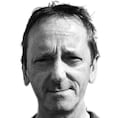When she was 18, Deirdre O’Callaghan hightailed it to London the day after she completed her Leaving Cert.
Not to hang around and wait for her results but rather to get out of Co Cork and entertain notions of going to art college, and perhaps even move to Paris to try out the chic bohemian lifestyle.
But, London had other ideas.
0 of 3
Quickly enough, O'Callaghan started working in a printing company in Soho. Happy to be involved with any aspect of photography, she says her life took a shift sideways when, through photo lab work, she met a young Scottish photographer by the name of John Waddell.
Within a short space of time, Waddell would become known by virtually everyone in the fashion world by his middle name, Rankin, who would go on to become one of the world’s most-respected fashion photographers.
Back in the early 1990s, recalls O’Callaghan with a broad smile almost hidden by her curls, Rankin was unknown, and she was working “the 24-hour lab thing”.
Exciting
“It didn’t stop and, for me, the most interesting people were coming into us late at night. It’s like that time in your life when you meet people that will become incredibly inspirational and important – Rankin had the drive and energy that was really exciting.”
Along with Rankin and Jefferson Hack, O'Callaghan helped bring to life Dazed & Confused (rebranded Dazed in 2014), in its time one of the most important British culture and fashion glossy monthly magazines.
“I worked with Rankin on shoots, and then became more involved as a picture editor. Looking back, it’s a wonder how we all survived. No one had any money, but we did it.”
O’Callaghan worked at the magazine for about five years. She loved the blend of music, pop culture and fashion (“shooting the whole time, travelling all over the place”).
She eventually made it to Paris, too, for a feature spread on French hip-hop (“I love French hip-hop!”) and the country’s nascent foray into electronic music (“early Daft Punk”).
Other creative considerations were afoot, however.
While she was working with Dazed & Confused (as well as with major acts such as U2, The National, Laura Marling, Damon Albarn, Peaches and Gang Starr), she was generating long-term personal projects that touched on themes of community.
Her first book, Hide That Can, was the result of a four-year project photographing expat Irish men in Arlington House, a hostel in Camden, London.
Love of music
Her latest, The Drum Thing, marries her love of music with an essentially community-based occupation.
The book features images and interviews with around 100 drummers. She likes, she says, to always have “something on the go”, but the durational projects have to have some level of emotional resonance.
Her next book is about the residents of New York's famous Chelsea Hotel.
If the sumptuous thought of photographer Diane Arbus crossed with Humans of New York springs to mind, what, then, of The Drum Thing?
Unless they're very famous (such as Dave Grohl, Ginger Baker, Ringo Starr, Larry Mullen Jr, all of which O'Callaghan nabbed), as a species, drummers aren't always recognisable and they are rarely interviewed outside the confines of specialist publications.
But, O'Callaghan says her group – which also includes Steve Gadd, Stewart Copeland, Questlove, Jim Keltner, Jack White, Neil Peart, Jaki Liebezeit, Sly Dunbar, Lars Ulrich and Tony Allen – had terrific tales to tell.
“You have stories of people who just couldn’t stop themselves banging pots and pans, tapping here, there and everywhere from when they were kids – lots of that. But then you have stories of people flicking coins and ending up playing drums. Even when I was transcribing the interviews, I could hear tapping going on.”
There is a dearth of female drummers in the book, but O’Callaghan attributes this to age profile. It doesn’t mean she’s happy about it, though.
“It’s a reflection on how it is. Yes, I would’ve loved to have had more, and I certainly tried to get them. I really wanted to get Yoshimi P-We of Japanese band Boredoms, but scheduling it was impossible.
“It was the same with [American drummer] Sheila E, and quite a few drummers in NYC – they just didn’t happen.”
This frustrating omission aside, there’s no doubting the veracity and visual dynamic of The Drum Thing.
The clincher, says O’Callaghan, was being allowed access to normally private spaces.
“When you’re invited into someone’s house it means they’re up for it. It’s a measure of the interview, and everything else, going very well.”
The Drum Thing – what started it
"It was a gig by Jon Spencer Blues Explosion at, I'm fairly sure, the Brixton Academy in London – the drummer, Russell Simms, just blew me away. That was one of the moments about drummers that stuck with me," says O'Callaghan.
“As for putting together a list of drummers, it started as a feature for Dazed & Confused magazine, but then I felt it needed to be bigger.
“Early on in the project, I came to a decision not to photograph drummers at gigs, but instead at their homes or studios – private spaces.
“And from there it developed that I’d also interview them after the photos were taken – short interviews but in a private setting.
“All those details you come across in home or studio/rehearsal environments are so much more interesting – finding out where people have their kits set up, whether it’s their garage, front room, in a basement, or wherever. And going into people’s homes made everything so much more relaxed.
“The photos were a lot more interesting and so, too, the interviews.”
The Drum Thing is published by Prestel. See deirdreocallaghan.com





















